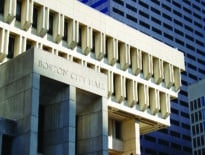Boston officials are offering a public subsidy as they prepare to seek a new round of private development proposals for Charlestown’s derelict Pier 5.
Neighborhood opposition, financial uncertainties and waterfront regulations all have combined to delay previous attempts to repair the nearly 2-acre pier and attract new residential or commercial uses.
In 2020, three local developers submitted plans to build up to 138 housing units including floating dwellings, but the Boston Planning & Development Agency rejected them citing safety concerns and financing questions.
Now, the agency is charting a different course and offering up to $8 million toward repair or demolition of the pier as part of a redevelopment. The agency’s board of directors is scheduled to review the request for proposals at Thursday’s monthly meeting,
A Cushman & Wakefield appraisal concluded that a commercial marina is the highest and best use of the property, but the Boston Planning Department stated in a memo that a marina is not the only development option. An urban renewal plan also allows hotel and residential uses.
Some residents of waterfront condominiums objected to the previous proposals, which included buildings up to 45 feet. The current offering would favor proposals with maximum heights of 35 feet that preserve Boston Harbor views.
The large concrete pier, built in 1943 by the U.S. Navy, sits on 1,650 steel piles but has been closed to the public for more than a decade.
The Boston Redevelopment Authority acquired the pier at the end of Eighth Street in 1979 following the Charlestown Navy Yard’s closure in 1974.
An inspection conducted in summer 2023 by Foth Infrastructure and Environment rated the pier’s condition as “serious” due to severe corrosion. Costs of repairs, demolition and replacement range from $10.8 million to $32.9 million, the consultants estimate.
Previous development proposals included 89 housing units in 2007 and a trio of submissions in 2020.
For the latest offering, development objectives include diversity, waterfront access and education, open space and cultural venues, sustainability and economic opportunities for small businesses, artists and nonprofits.









